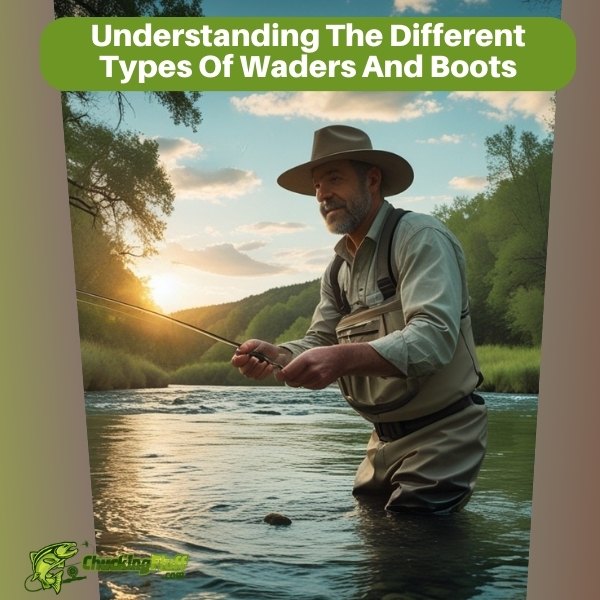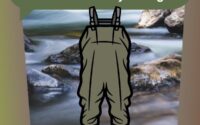| Disclosure: Just to be open and honest the buttons and links you click on in the website will in most cases take you to another website where you can purchase the products I am reviewing. As an Amazon Associate I earn from qualifying purchases. |
Understanding The Different Types Of Waders And Boots
Quick Post Navigation
Introduction
Imagine stepping into a river, the cool water swirling around your legs, but instead of feeling the chill, you’re completely dry and comfortable. That’s the magic of having the right waders and boots. Whether you’re fly fishing, hunting, or working in wetlands, your choice of waders and boots can make or break your experience.
But with so many styles, materials, and features available, how do you pick the perfect pair? This guide breaks down everything you need to know—covering different types of waders, materials, boot options, and expert tips to ensure you invest in the best gear.
What Are Waders?
Waders are waterproof overalls or pants designed to keep you dry while walking through water. Unlike standard waterproof clothing, waders are built for full or partial submersion, allowing you to stand in rivers, lakes, or marshes without getting wet.
They’re used primarily by anglers, hunters, and workers in wet environments. The right waders provide insulation, comfort, and durability, helping you stay focused on your activity instead of worrying about the cold or dampness.
Different Types of Waders
Waders come in various styles, each suited for different environments and activities. Understanding their differences helps in selecting the best option for your needs.
1. Chest Waders – Full Protection for Maximum Coverage
Chest waders extend from the feet up to the chest, providing full-body coverage. They’re perfect for deep water fishing, cold conditions, and unpredictable weather.
✅ Best for:
- Deep rivers, lakes, and marshlands
- Cold-weather fishing
- Maximum protection against water and debris
❌ Cons:
- Heavier than other waders
- Can be too warm in hot weather
- More expensive
Most chest waders come with adjustable suspenders, built-in pockets, and reinforced knees for extra durability. If you’re fishing in unpredictable conditions, chest waders are your best bet.
2. Waist-High (Hip) Waders – A Balance Between Mobility & Protection
Waist-high waders, also called hip waders, offer mid-range protection while allowing for more freedom of movement. They’re perfect for shallow waters where you don’t expect to wade deeper than your waist.
✅ Best for:
- Streams and shallow rivers
- Warm-weather fishing
- More mobility than chest waders
❌ Cons:
- Limited protection against deeper water
- Less insulation in cold weather
These waders are ideal for anglers who prefer flexibility without committing to full-body coverage.
3. Thigh Waders – Lightweight & Easy to Wear
Thigh waders cover the legs up to the thighs and are the most lightweight option. They’re great for fishing in small creeks, shallow streams, and marshes.
✅ Best for:
- Quick fishing trips
- Wading through shallow water
- Hot weather conditions
❌ Cons:
- Minimal coverage—water can easily overflow
- Less protection from cold and rough terrain
For anglers who prioritize convenience and only wade in knee-deep water, thigh waders are an excellent choice.
Wader Materials: Pros and Cons
Waders come in different materials, each with unique strengths and weaknesses. The right material depends on the climate, water conditions, and personal comfort preferences.
1. Neoprene Waders – Best for Cold Weather
Neoprene is a thick, insulating material similar to what’s used in wetsuits.
✅ Pros:
- Excellent insulation, keeping you warm in icy waters
- Durable and resistant to punctures
- Available in different thicknesses (3mm-5mm) for varying climates
❌ Cons:
- Heavy and bulky
- Poor breathability, leading to overheating in warm weather
Neoprene waders are the go-to choice for winter fishing, ice fishing, or duck hunting in frigid conditions.
2. Breathable Waders – All-Season Comfort
Made from advanced fabrics like Gore-Tex or nylon, breathable waders allow moisture to escape while keeping water out.
✅ Pros:
- Lightweight and comfortable
- Ideal for all-day fishing trips
- Versatile—layer up for cold weather, wear light for warm weather
❌ Cons:
- Less insulating than neoprene
- Generally more expensive
Breathable waders are perfect for anglers who fish year-round and need adaptable gear.
3. Rubber Waders – Heavy-Duty Protection
Rubber waders are the most durable and 100% waterproof, making them great for muddy or hazardous environments.
✅ Pros:
- Tough and puncture-resistant
- Fully waterproof
- Ideal for working in industrial or hazardous waters
❌ Cons:
- Heavy and uncomfortable for long-term wear
- Poor breathability
Rubber waders are often used for commercial fishing or industrial work rather than recreational fishing.
Bootfoot vs. Stockingfoot Waders
One key choice when buying waders is whether to go with bootfoot or stockingfoot styles. Each has its own advantages.
1. Bootfoot Waders – Easy to Slip On & Off
Bootfoot waders have built-in boots, making them easy to wear without needing separate wading boots.
✅ Pros:
- Convenient and quick to put on
- No need to buy separate boots
- Ideal for colder conditions
❌ Cons:
- Less ankle support
- Bulkier and harder to pack
Bootfoot waders are great for beginners and those who value convenience over customization.
2. Stockingfoot Waders – Better Fit & Performance
Stockingfoot waders require a separate pair of wading boots, offering greater flexibility and comfort.
✅ Pros:
- Better traction and support
- More versatile—choose your own boots
- Lightweight and easier to pack
❌ Cons:
- Requires an extra purchase (wading boots)
- Slightly more effort to put on and take off
Stockingfoot waders are the preferred choice for serious anglers who need stability and customization.
Understanding Wading Boots
If you choose stockingfoot waders, you’ll need a good pair of wading boots. These boots provide grip, ankle support, and durability when walking on wet, slippery surfaces.
Types of Wading Boots:
- Felt Sole Boots – Great traction but banned in some areas due to invasive species concerns.
- Rubber Sole Boots – Durable, legal everywhere, and provide solid grip.
- Studded Boots – Ideal for extreme traction on rocky, slippery terrain.
How to Choose the Right Waders and Boots
When selecting waders and boots, consider these factors:
- Durability – Check for reinforced seams and tough materials.
- Fit & Comfort – Snug but not too tight; allow for movement.
- Water Conditions – Cold? Neoprene. Warm? Breathable.
- Price – Invest in quality; cheap waders wear out quickly.
Care & Maintenance of Waders and Boots
To extend the life of your gear:
- Rinse after use to remove dirt and salt.
- Dry completely before storing to prevent mold.
- Store in a cool, dry place to avoid cracking.
- Repair small leaks immediately with patch kits.
Conclusion
The right waders and boots can make your fishing trips safer, drier, and more enjoyable. Whether you need chest waders for deep rivers, lightweight thigh waders for shallow streams, or heavy-duty rubber boots for rugged terrain, knowing what to look for ensures you get the best gear for your needs.
FAQs
1. What’s better: bootfoot or stockingfoot waders?
Stockingfoot waders are better for serious anglers due to their comfort and flexibility, while bootfoot waders are more convenient for casual use.
2. How do I know my wader size?
Check manufacturer sizing charts and consider layering clothes underneath.
3. Can I use hiking boots with stockingfoot waders?
No, hiking boots don’t offer proper drainage and support for wading.
4. Are breathable waders waterproof?
Yes! They keep water out while allowing moisture from sweat to escape.
5. How long do waders last?
With proper care, quality waders can last 5-10 years.



